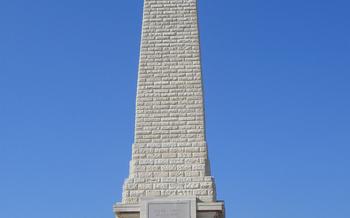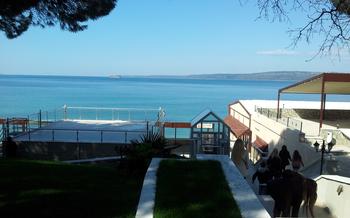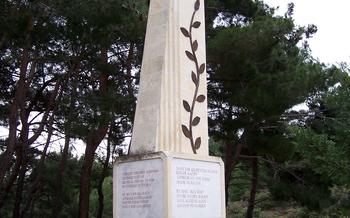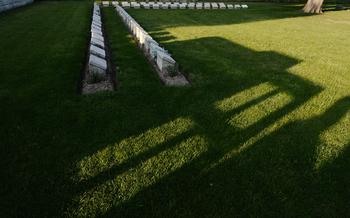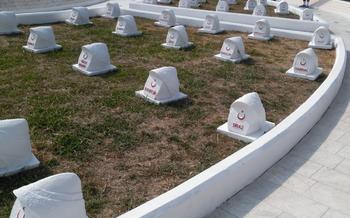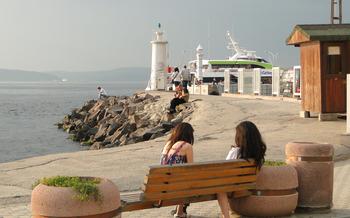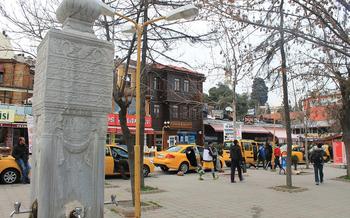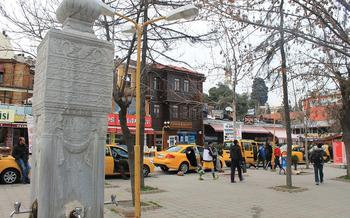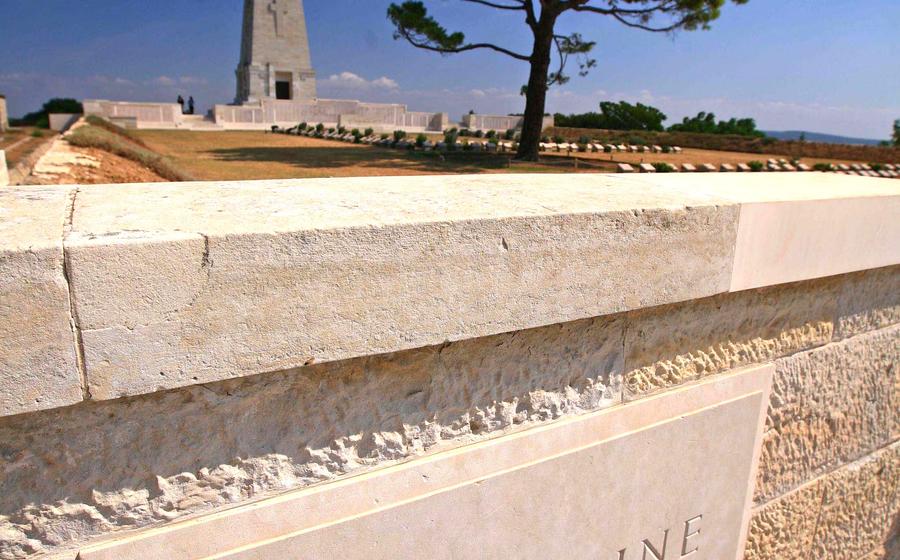
The Lone Pine Memorial
- The Lone Pine Memorial: A Corner of Australia in Gallipoli
- Location and Getting There
- The Lone Pine Trenches: A Journey Through History
- Commemorative Services
- Lone Pine Cemetery
- Gallipoli Campaign Historical Background
- Lone Pine Battle
- ANZAC Spirit
- Gallipoli Peninsula National Park: A Natural Haven Steeped in History
- Çanakkale Martyrs’ Memorial: Honoring Turkish Soldiers’ Sacrifice
- Local Cuisine and Culture:
- Insider Tip: Unveiling Hidden Treasures of Lone Pine
The Lone Pine Memorial: A Corner of Australia in Gallipoli
The Lone Pine Memorial stands as a poignant testament to the sacrifice and bravery of Australian soldiers who fought and died during the Gallipoli Campaign. Situated on the Gallipoli Peninsula, a place forever etched in the annals of military history, the memorial commemorates the fierce Battle of Lone Pine, where Australian troops displayed unparalleled courage and resilience.
Architecturally, the memorial is a masterpiece of simplicity and reverence. Designed by the Australian sculptor, Charles Web Gilbert, it features a striking obelisk that rises majestically from a serene garden setting. The obelisk, adorned with bronze plaques, bears the names of over 4,000 Australian soldiers who lost their lives at Lone Pine and whose remains lie in unmarked graves.
At the heart of the memorial lies the Lone Pine tree, a symbol of enduring hope and resilience. This lone survivor of the battle, despite the ravages of war, stands as a testament to the indomitable spirit of the Australian soldiers. Its gnarled trunk and windswept branches serve as a reminder of the harsh conditions they endured and the sacrifices they made for their country.
Location and Getting There
The Lone Pine Memorial is situated on the Gallipoli Peninsula, approximately 12 kilometers south of the town of Eceabat. To reach the memorial, visitors can take a ferry from Çanakkale, the main city on the peninsula, to Eceabat. From there, they can either take a taxi or join a guided tour that includes transportation. Guided tours offer a more comprehensive experience, as they provide historical context and insights into the significance of the memorial.
For those with limited mobility, the memorial is wheelchair accessible, ensuring that everyone can pay their respects to the fallen soldiers. Visitors should note that the site can be crowded, especially during peak tourist season and on commemorative days such as ANZAC Day. It is advisable to plan accordingly and arrive early to avoid long queues.
The Lone Pine Trenches: A Journey Through History
The Lone Pine Memorial stands amidst an extensive network of trenches that were once the scene of fierce battles during the Gallipoli Campaign. These trenches, now preserved as a poignant reminder of the soldiers' sacrifices, offer a unique glimpse into the harsh realities of trench warfare.
Exploring the trenches is like stepping back in time. Visitors can trace the intricate paths, peer into dugouts where soldiers sought shelter, and imagine the deafening roar of battle that once echoed through these narrow passageways. The trenches serve as a tangible connection to the experiences of the soldiers who fought and died on this hallowed ground.
Safety measures and guidelines are in place to ensure that visitors can safely navigate the trenches. Designated pathways help prevent damage to the site, and signs provide information about the history and significance of each section. While exploring the trenches, visitors are encouraged to maintain a respectful silence, honoring the memory of those who lost their lives in this historic battle.
Commemorative Services
The Lone Pine Memorial serves as a poignant site for annual ANZAC Day services, held on April 25th each year. ANZAC Day, observed in Australia and New Zealand, commemorates the sacrifices of soldiers who fought in all wars, particularly the Gallipoli Campaign.
The Lone Pine ANZAC Day service holds particular significance, attracting thousands of visitors from around the world, especially descendants of the fallen soldiers. The solemn atmosphere during the service is palpable as attendees pay their respects and remember the bravery and sacrifice of those who fought at Lone Pine and throughout the Gallipoli Campaign.
The service typically begins with the playing of the Last Post, followed by a wreath-laying ceremony and prayers. Representatives from the Australian and New Zealand governments, along with military personnel and descendants of ANZACs, deliver heartfelt speeches honoring the fallen. The service concludes with a minute of silence, allowing attendees to reflect on the immense loss and the enduring legacy of the Gallipoli Campaign.
Visitors are welcome to attend the ANZAC Day service and participate in the commemorative events. It is a moving experience that provides an opportunity to pay tribute to the soldiers who fought and died at Lone Pine and to remember the significance of the Gallipoli Campaign in the history of Australia and New Zealand.
Lone Pine Cemetery
In the immediate vicinity of the Lone Pine Memorial, visitors will find the Lone Pine Cemetery, a respectful and serene resting place for Australian soldiers who lost their lives during the battle. Rows of simple headstones, each bearing the name, rank, and regimental details of a fallen soldier, create a poignant and solemn atmosphere. The grounds are immaculately maintained, with manicured lawns and colorful flower beds adding a touch of beauty to the otherwise somber surroundings.
Visitors to the cemetery can pay their respects and learn about the stories of individual soldiers by reading the inscriptions on the headstones. Many of the graves are adorned with photographs, personal belongings, and messages left by family members and fellow soldiers, creating a deeply personal and moving experience for those who visit. The Lone Pine Cemetery serves as a constant reminder of the sacrifices made by Australian soldiers during the Gallipoli Campaign and is a place where visitors can reflect on the futility of war and the importance of remembrance.
Gallipoli Campaign Historical Background
The Gallipoli Campaign, also known as the Dardanelles Campaign, was a significant military campaign of World War I that took place on the Gallipoli Peninsula in the Ottoman Empire (present-day Turkey). The campaign began on April 25, 1915, with the landing of Allied forces, primarily from Australia, New Zealand, and Britain, with the aim of securing the Dardanelles Strait and capturing the Ottoman capital of Constantinople (present-day Istanbul).
The campaign was initially conceived as a naval operation to force the Dardanelles Strait, but it quickly evolved into a large-scale land campaign. The Allied forces faced fierce resistance from the Ottoman army, led by Mustafa Kemal Atatürk, and the campaign ultimately ended in a costly defeat for the Allies. The withdrawal of Allied troops from Gallipoli was completed in January 191
The Gallipoli Campaign had a profound impact on Australia and New Zealand, as it marked the first major military engagement for both countries. The campaign also played a significant role in shaping the national identities of both countries, and the ANZAC Day holiday, which commemorates the anniversary of the Gallipoli landings, is a major national holiday in both countries.
Key Points:
- The Gallipoli Campaign was a significant military campaign of World War I that took place on the Gallipoli Peninsula in the Ottoman Empire.
- The campaign began on April 25, 1915, with the landing of Allied forces, primarily from Australia, New Zealand, and Britain.
- The campaign was initially conceived as a naval operation but quickly evolved into a large-scale land campaign.
- The Allied forces faced fierce resistance from the Ottoman army, and the campaign ended in a costly defeat for the Allies.
- The Gallipoli Campaign had a profound impact on Australia and New Zealand, shaping their national identities and leading to the establishment of ANZAC Day as a major national holiday in both countries.
Lone Pine Battle
The Battle of Lone Pine, fought between August 6th and 10th, 1915, stands as a pivotal moment in the Gallipoli Campaign. It was a fierce and bloody clash between the Australian and New Zealand Army Corps (ANZACs) and the Ottoman forces, with both sides suffering heavy casualties. The battle's strategic importance lay in its objective: the capture of Lone Pine, a strategically located hill that overlooked the Turkish positions.
The ANZACs, determined to break the stalemate, launched a surprise attack under the cover of darkness. After intense fighting, they succeeded in capturing the hill, but the Ottomans counterattacked relentlessly. The battle raged for days, with both sides trading control of the position multiple times.
The Australians' tenacity and courage shone through amidst the chaos and bloodshed. Despite suffering heavy losses, they held their ground, earning the respect and admiration of both their allies and their adversaries. The battle ultimately ended in a stalemate, but the ANZACs had achieved their goal of diverting Turkish attention and resources away from other sectors of the front.
The Battle of Lone Pine left an indelible mark on the Australian psyche. It became a symbol of the courage, mateship, and resilience of the ANZACs, qualities that would come to define the nation's identity. The battle also highlighted the horrors of war and the futility of the Gallipoli Campaign, which ultimately ended in a costly defeat for the Allied forces.
ANZAC Spirit
The term "ANZAC spirit" encapsulates the qualities of courage, mateship, and resilience that were displayed by the Australian and New Zealand soldiers who fought in the Gallipoli Campaign. These qualities are deeply ingrained in the national identities of both countries and are considered to be defining characteristics of their military heritage. The Lone Pine Memorial stands as a powerful symbol of this spirit, embodying the sacrifices and achievements of the ANZACs who fought and died at this iconic battleground.
The memorial's design and location reflect the ANZAC spirit in several ways. The simple yet dignified architecture conveys a sense of respect and remembrance, while the use of native Australian flora in the landscaping pays tribute to the soldiers' homeland. The memorial's position atop a hill overlooking the battlefield adds to its significance, as it serves as a reminder of the soldiers' determination and courage in the face of overwhelming odds.
The Lone Pine Memorial is a place where visitors can come to learn about the ANZAC spirit and its enduring legacy. It is a place to remember the sacrifices of those who served and to honor their contribution to the history of Australia and New Zealand. The memorial is not just a monument but a living symbol of the ANZAC spirit, a spirit that continues to inspire and unite people to this day.
Gallipoli Peninsula National Park: A Natural Haven Steeped in History
Beyond the poignant memorials and battlefields, the Gallipoli Peninsula National Park beckons with its unspoiled natural beauty and historical significance. Encompassing the entire peninsula, the park offers a sanctuary for diverse flora and fauna, while preserving the legacy of the Gallipoli Campaign. Immerse yourself in the tranquility of nature as you explore walking trails that wind through dense pine forests, blooming meadows, and rugged cliffs. Discover hidden coves and secluded beaches, where the crystal-clear waters invite you to swim, snorkel, or simply bask in the sun.
Amidst this scenic backdrop, you'll find remnants of the war that once raged here. Old trenches, bunkers, and shell craters serve as silent witnesses to the fierce battles that took place. Explore these relics with respect and awe, paying tribute to the soldiers who fought and fell on this hallowed ground. The Gallipoli Peninsula National Park is a place of profound natural beauty and historical significance, where visitors can connect with the past while embracing the serenity of the present.
Çanakkale Martyrs’ Memorial: Honoring Turkish Soldiers’ Sacrifice
While visiting the Lone Pine Memorial, take a moment to pay your respects at the nearby Çanakkale Martyrs’ Memorial, dedicated to the Turkish soldiers who fought and died during the Gallipoli Campaign. This memorial, situated on a hilltop overlooking the Dardanelles Strait, commemorates the sacrifices made by the Turkish army in defending their homeland.
The Çanakkale Martyrs’ Memorial features a striking obelisk-shaped monument, surrounded by a tranquil garden and rows of tombstones. The names of over 57,000 Turkish soldiers who lost their lives in the campaign are inscribed on the memorial, serving as a poignant reminder of the immense loss suffered by Turkey.
Comparing the Lone Pine Memorial and the Çanakkale Martyrs’ Memorial, one can appreciate the shared spirit of remembrance and respect for the fallen soldiers of both nations. While the Lone Pine Memorial honors the Australian and New Zealand troops, the Çanakkale Martyrs’ Memorial pays tribute to the Turkish soldiers who fought valiantly in defense of their country.
Visiting both memorials allows visitors to gain a comprehensive understanding of the Gallipoli Campaign from multiple perspectives, fostering a sense of reconciliation and acknowledging the common sacrifices made by all those who fought in this historic battle.
Local Cuisine and Culture:
Immerse yourself in the flavors of traditional Turkish cuisine during your visit to Çanakkale or Eceabat. Explore local restaurants that serve authentic dishes like "Çanakkale Köfte" (meatballs) and "Geyik Eti" (venison meat). Savor the freshest seafood, including "Midye Dolma" (stuffed mussels) and "Kalamar" (squid), caught daily from the Aegean Sea. Don't miss the chance to try "Çanakkale Ayranı," a refreshing yogurt drink, and indulge in Turkish delight, a sweet treat made with pistachios or walnuts.
While enjoying the local cuisine, take the opportunity to interact with the warm and welcoming Turkish community. Respect local customs and traditions by dressing modestly and greeting people with a friendly "Merhaba" (hello). Learn a few basic Turkish phrases to communicate with locals and show your appreciation for their culture. Attend local events or festivals related to the Gallipoli Campaign, such as the Çanakkale Martyrs' Day Commemoration, to gain a deeper understanding of the region's history and culture.
Insider Tip: Unveiling Hidden Treasures of Lone Pine
Beyond the poignant Lone Pine Memorial, the Gallipoli Peninsula holds secret spots that offer unique experiences and breathtaking views. Venture off the beaten path to discover hidden gems that will enrich your visit.
-
Lone Pine Lookout: Ascend to the heights of Lone Pine Lookout for a panoramic vista that will leave you breathless. Capture stunning photographs of the memorial, the vast Gallipoli Peninsula, and the shimmering Aegean Sea.
-
Quinn's Post: Explore the nearby Quinn's Post, an iconic battlefield site where ANZAC and Turkish soldiers engaged in fierce trench warfare. Immerse yourself in the preserved trenches and bunkers, providing a glimpse into the harsh realities of combat.
-
Beach Cove: Seek solace and tranquility at Beach Cove, a secluded beach tucked away near the memorial. Relax on the sandy shores, soak in the serene atmosphere, and reflect on the sacrifices made during the Gallipoli Campaign.
-
Local Festivals: Time your visit to coincide with local festivals or commemorative events related to the Gallipoli Campaign. These events offer a vibrant glimpse into Turkish culture and provide an opportunity to engage with the local community.
-
Historical Reading: Delve deeper into the history of Gallipoli by immersing yourself in recommended books and documentaries. "Gallipoli" by Les Carlyon and "The Turkish Gallipoli" by Edward J. Erickson offer insightful perspectives on the campaign.
